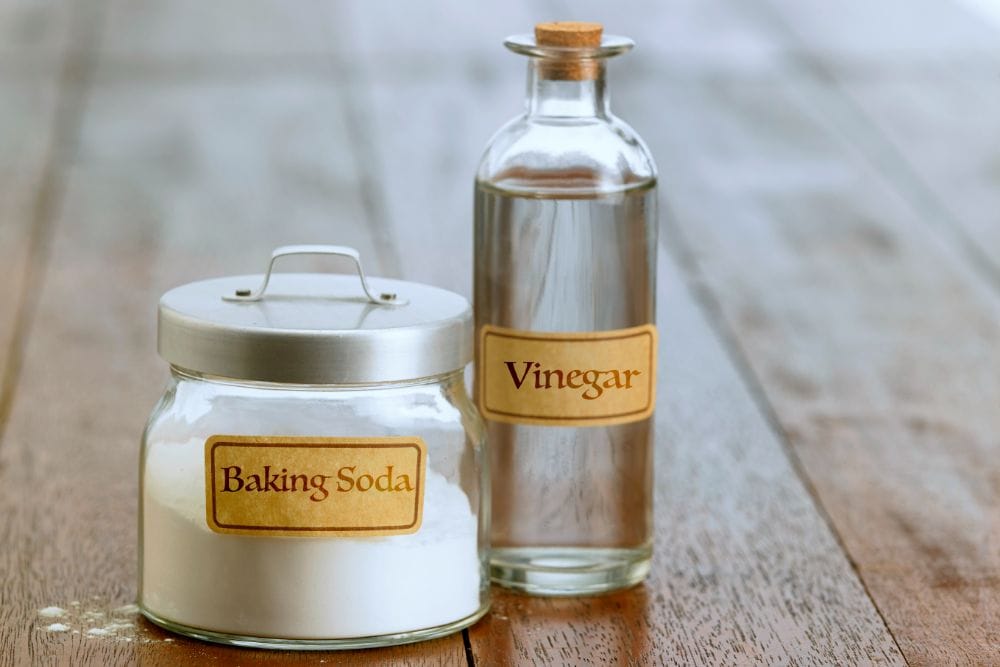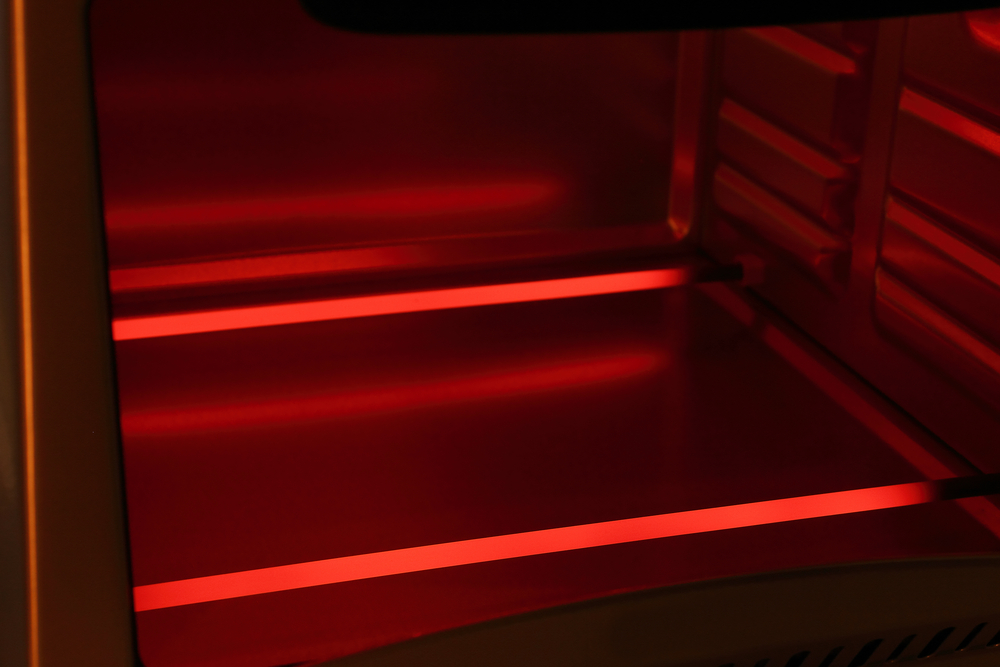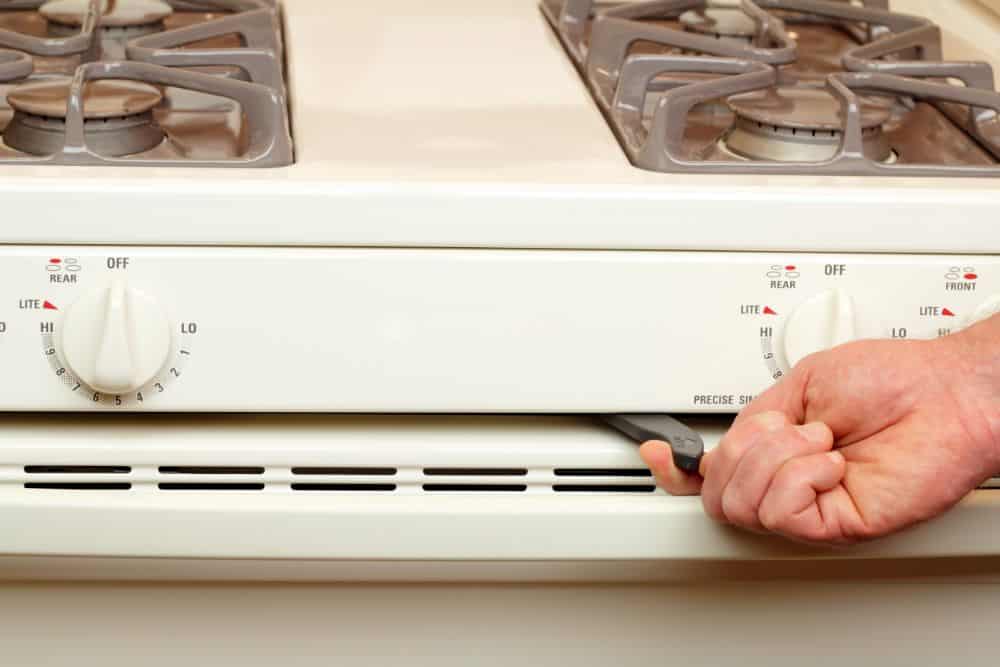You bought a new range and can’t wait to prepare your favorite dish. However, a few minutes into cooking, you identify a foul smell of burning plastic and chemical residue lingering in your kitchen.
Upon further inspection, you determine that the new oven emits the odor.
What could be the problem?
Is your new electric oven faulty?
Could some parts be missing?
Can you cook immediately after getting a new stove?
These and many other questions may linger in your mind.

Getting a New Oven is Exciting - But There Are Some Things You Need to Do Before You Start Baking Fresh Cookies
You may quickly realize that cooking food in a new range isn’t the best idea. The oven releases a foul smell that could leech into your food if not eliminated from the onset.
As alarming as the situation appears, there’s no need to worry. It’s normal for a new oven to release a foul smell, and there are ways of eliminating it. Read on to find out what causes the odor and how to get rid of it.
Typically when the insulation around the oven cavity is heated for the first time, it will emit a foul odor and oven smoke. The insulation may contain an acrylic binding agent or formaldehyde, which isn’t supposed to be exposed to the oven's interior when hot.
If exposed, it releases a strange smell, which disappears after a few uses.

A Brand New Oven
Sometimes it lingers longer (up to a week), and a burn-in cycle helps eliminate the smell. It could also be that you didn’t remove the zip or paper ties used to secure the inserts when transporting the oven.
If that’s the case, the ties burn, emitting an odd smell. This odor is somewhat different from the first, disappearing once the plastic or paper burns.
New gas ovens also smell when the protective coating of oil burns. The oil coating is petroleum-based, and lighting up the stove initiates an off-gassing process that emits a foul smell.
New ovens also smell when the interior enamel off-gases.
This Sears Video Recommends Going Through One Or More Cooking Cycles to Burn Off the Excess Oils Inside a New Oven
Most ranges have a self-cleaning cycle that emits toxic and foul-smelling chemicals. Whatever the reason, there are many ways to remedy the problem.

A Woman Opening a Kitchen Window During the Burn in Process to Allow for Proper Ventillation
Although burnt coating oil smells like plastic fumes, it’s not dangerous. The smell can be misleading, but there’s no need to worry.
Besides, a new oven smell is normal. It’s only dangerous to one’s health if inhaled for extended periods.
The first step is to turn off the appliance and open the door and windows to allow ventilation. You must also keep birds and pets away from the kitchen because the fumes can be lethal.
Chemicals released during a burn-in cycle are toxic enough to kill birds.
You must understand that the foul smell is common to all new oven types, including electric ovens, convection ovens, and gas ovens. The remedies discussed below apply regardless of the type of oven used.
Most parts of a new oven come wrapped in plastic, and you must remove the covering before using the oven. The plastic wraps protect the small and delicate segments from damage during transit.
An electric stove, for example, comes with an oven rack wrapped in a plastic cover.
Many people inspect the range for dents or dings on the metal surface. Other features such as a bent power cord or a faulty oven door could compromise its function.
Check the heating element to ensure it’s firmly attached to the oven's walls.
If using a gas oven, for example, check if the igniter is loose. Identifying damaged parts on electric stovetops can be challenging, but turning it on and off a few times should tell you if it’s faulty.
Manufacturers may use metal or plastic twist ties to shut some oven parts during shipment. Check the corners of the oven and remove them using a knife or scissors. If left unattended, you risk burning them.

Baking Soda and Apple Cider Vinegar Combine to Create a Highly Effective Cleaning Solution
After the inspection, wipe the racks and the insides of the unit with a damp cloth soaked in warm, soapy water. You must avoid using harsh cleaning agents as they could strip off the oven’s protective coating.
However, if your cleaning itinerary consists of powerful products, look for an alternative oven cleaner. Some people make a cleaning solution using baking soda and apple cider vinegar.
The mixture is beneficial when you want to get rid of the new oven scent and is less likely to cause any harm. Avoid using lots of water around the electric heating coils for electric ovens.
This action is the most critical step in eliminating the foul odor in a new oven. Skipping it leaves the new gases lingering in the range, and any food prepared thereafter develops a bad smell.
Moreover, the food absorbs chemicals, which may lead to food poisoning if consumed.

You May Have to Heat the Onion Through One or More Burn in Cycles Prior to Using the Oven for Baking
The best way to initiate the burn-in cycle is to turn the oven to 400-550 F (204-288 C). A strong, pungent smell released from the oven is a tell-tale sign that the cycle is in progress. If using an electric oven, the heating coils develop a red hot orange color.
The foul smell can be poisonous, so make sure that you:
Repeat the process once or twice if the foul odor doesn’t taper off after the first burn-in cycle. Then allow the oven to cool off and wipe the insides with warm, soapy water.
Alternatively, place a bowl of water in the oven and leave it for a few minutes. You may add lemon juice or leave it as is to create a humid atmosphere in the oven.
The vapors help loosen the oils and absorb any foul scent.
Here are a few tricks that may help reduce the bad smell in your house during the burn-in cycle.
Place activated charcoal around the house. The idea is to allow the charcoal to bond with the toxic fumes released during the burn-in process.
You can line it on baking trays for some time and discard it when finished.
Some people put a few bowls of baking soda around the kitchen to absorb the odors. You may also sprinkle the powder on furniture and rugs and vacuum them later.
The self-cleaning function was developed in the early 1960s for electric, gas, and convection ovens. The premise was to save homeowners the task of getting on their knees to scrape off stubborn gunk.

Avoid Using the Self Cleaning Oven Feature as it Comes with Risks to Your Health and to the Oven
Upon initiating the self cleaning feature, the oven would blast high heat or steam throughout the interior, burning up any hardened food remains.
For high-heat models, the feature is initiated by closing the oven door and pressing the self-clean mode.
Once the self cleaning cycle is complete and the oven cools down, the door opens automatically. Although the function is present in most gas, electric, and convection oven models, a burn-in process is most effective when the heat is turned up manually and left to burn for 30- 60 minutes.
Moreover, the self-cleaning function has disadvantages that could harm your family. Not only does it use more energy than required, but it also shortens an oven’s life.
Other reasons you shouldn’t use this feature during a burn-in cycle are:
The self-cleaning cycle leads to the emission of harmful toxins like carbon monoxide and PTFE (Polytetrafluoroethylene). Carbon monoxide is difficult to detect and highly toxic to humans and animals.
On the other hand, PTFE toxins are harmful to birds. A bird’s respiratory system sends oxygen to its flight muscles.
As such, if PTFE toxins are all the bird is inhaling, they are sent straight to its respiratory system endangering its life.
The high temperatures required for a self-cleaning cycle may cause fuses to blow out and control panels to burn. It can be challenging to perform appliance repair on such ovens because the device must be pulled from its compartment to access the affected area.
It’s best to avoid such inconveniences by manually performing the burn-in cycle. It can be time-consuming, but you preserve your family’s health and avoid a costly oven repair.
A self-cleaning cycle causes the Teflon coating in the interior of a new oven to produce toxic fumes, which affect people with respiratory diseases. Although the coating withstands regular broiling and baking temperatures, extreme temperatures have detrimental effects.
A single self-cleaning cycle consumes up to 8 kilowatt-hours of energy. This amount is more than double a regular cooking cycle which requires less than 3 kWh of energy.
So, can you cook immediately after getting a new oven? Follow manufacturer recommendations and instructions. That said, it is likely that a new oven will require one or more burn-in cycles.
Cooking food in a new oven is likely to produce a foul odor during the first few uses that can affect the quality and safety of your food. That’s because the heat from the oven burns the layer of oil used in the manufacturing process.
You must clean the interior and perform a burn-in cycle to eliminate the characteristic odor in new ovens before use. Food cooked in a new oven without performing the two steps is likely to develop a pungent odor and can harm your family members.
You can also have that “new oven smell” with an air fryer. You’ll always want to read the directions when getting any new appliance before cooking that first meal. It is likely that you’ll be instructed to run your air fryer for a couple of burn-in heating cycles without food to release plastic fumes and keep them out of your food. Uber Appliance recommends that you go through this empty baking cycle a couple of times when you’re breaking in a new air fryer.
It can be harmful - make sure that your house is well ventilated. The smell is similar to plastic fumes and irritates pets, birds, and people with respiratory problems. Asthmatic people are likely to cough and sweat after inhaling the vapors.
No, it won’t make you sick if you’ve followed the pre-requisites for using a new oven. You must clean it and allow it to heat up to high temperatures of 400-500 F. Burning it up eliminates the foul odor that could make people with respiratory problems sick.
A new oven takes 25-30 minutes to heat up. New models have larger compartments which add to the time a range takes to heat up. You can activate the pre-heat function to hasten the process.
The smell dissipates after a few uses. The period can vary from a day to a week, depending on the coating used.
